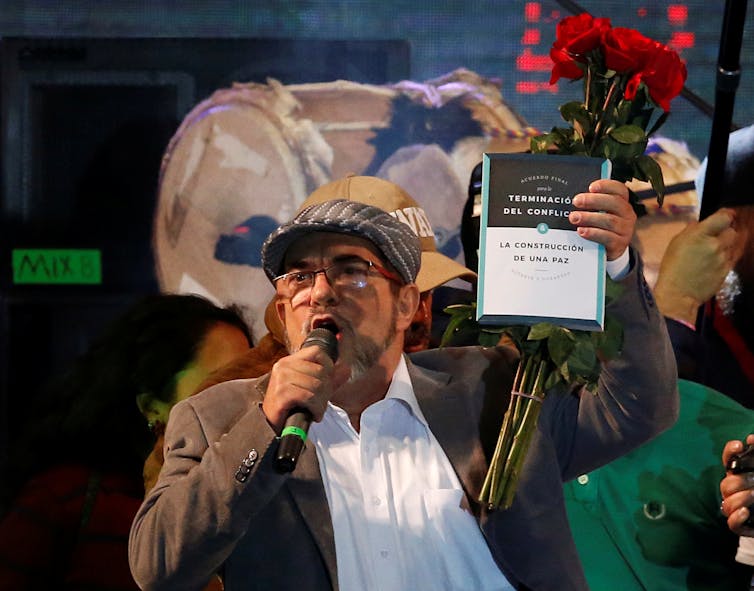Ever since Colombia signed its fragile, contested peace agreement with the Revolutionary Armed Forces of Colombia (FARC) in November 2016, the big question has been: What will this no-longer-armed insurgency do next?
On Aug. 28, the FARC made its official reply. In its first congress since disarmament, the Marxist guerrilla group unveiled Colombia’s newest political party: the Fuerza Alternativa Revolucionaria del Común, or Commoners’ Alternative Revolutionary Force.
“The new party will be built with many voices and diverse ideas,” announced Rodrigo Londoño Echeverri, the FARC’s top commander, via Twitter.
In keeping their well-known acronym but setting aside the violence, the FARC seems to be embracing the opportunities and obligations of the 2016 accords. These enabled former combatants to participate in Colombia’s political system after disarmament – including, controversially, allocating the group 10 congressional seats for a period of two four-year terms.
As the campaign season for the 2018 presidential and congressional elections heats up, everyone is now wondering whether this insurgency turned political party can find its place on Colombia’s political stage.
New horizons
For five decades, the FARC used violence to push its Marxist agenda of land reform and anti-capitalist revolution, forestalling political solutions to social problems and silencing the voice of millions of Colombians.
In doing so, it also launched a roiling armed conflict that turned eight million people into victims of homicide, terrorism, grievous injury and displacement.
The FARC maintains that it resorted to armed struggle because the Colombian political elite ran the country like a caste system, ignoring the struggles of the rural and peasant classes, which for much of the 20th century accounted for 70 percent of Colombia’s population.
The FARC is now hoping to position itself as the party for these marginalized voters. To succeed, it must develop new organizational capacities, including the ability to process internal dissent and debate while maintaining party unity – a tricky feat considering that several FARC units have already reneged on the peace agreements.
It must also build a political platform that can reach a wider segment of the Colombian electorate. Today, three-quarters of all Colombians live in cities. Voters in Bogota or Cali do not necessarily share the needs of the rural sectors that shaped the FARC’s political agenda.
The FARC’s leadership is clearly aware that low popularity is a weakness. Recently, FARC leadership invited the former soccer star Rene Higuita to run as a FARC congressional candidate, and they have made other clear bids to attract the general population.
There is certainly room for new voices in Colombia’s political debate. In the past, peace and security have topped Colombians’ list of concerns. But since the peace process, voters have turned their attention to other issues, including corruption and its role in the state’s inability to deliver services.
The FARC’s rhetoric during its armed struggle often centered on health care, public education and economic development, so it is now closely associated with demands for better state services. As such, the group has the potential to promote a political agenda of inclusion and to advocate for more effective solutions to the problems that concern Colombians across the country.
Room for debate
Signs of change are already afoot. Earlier this year, when the citizens of Buenaventura took to the streets to protest low wages and lack of basic services, newspapers reported dispassionately on the marches, giving voice to protestors’ grievances.
In the past, media commentators were generally quick to dub such marches as “FARC-inspired.” This effectively delegitimized peasants’ complaints of state neglect.
This subtle shift illustrates the political opening created by the peace process: The FARC’s absence as a violent actor makes a proper democracy possible in Colombia.
But the success of the new FARC will not depend entirely on its ability to attract public support. In this fractured nation, the group must also be seen as a force for reconciliation.
And, paradoxically enough, this is made possible by the fact that many powerful, hawkish Colombian politicians tried to derail last year’s accords, which allowed the new FARC to position themselves as agents of peace.
The Colombian establishment is unintentionally empowering the new FARC in other ways, too. For decades armed conflict and fear were used as a shield to cover up malfeasance by government officials and state institutions. Peace has made corruption far more visible, and it now sits squarely on the FARC’s agenda.
The Green Party, Liberal Party and some conservative parties, too, are starting to join the anti-corruption crusade.
Show me a leader
There’s one major hurdle, however, in the FARC’s thus far fortuitous rebirth: its graying hierarchy.
The average age of the FARC’s top leadership is 65, and Comandante Lodoño Echevarri, who also goes by Timochenko, has spent recent months in Havana under the care of Cuban doctors after a heart attack and seizure in July.
Timochenko is a respected rebel leader who successfully ended the group’s war on Colombia’s government, something numerous predecessors had failed to do. Some even anticipated that he would be nominated for a joint Nobel Peace Prize alongside President Juan Manuel Santos. He wasn’t.

Despite health issues, Timochenko has continued to lead the FARC through its transition from armed rebel group to political party.
Henry Romero/Reuters
Health issues aside, guerrilla commander and party boss are very different jobs. To build its constituency, the party will need a powerful and charismatic leader who embraces a discourse of peace and reconciliation, not war and confrontation.
One obvious contender among the many candidates currently receiving speculation is Luciano Marin, also known as Ivan Márquez, a former politician and FARC member who led the guerrilla group’s peace negotiations in Havana.
But there are also many civilians who came to the FARC from the labor movement, activism and the left-leaning Marcha Patriótica party. Choosing a leader unburdened by the group’s militaristic past would project a new image for the party. A young leader could speak more directly to the youth of Colombia.
Whoever takes the helm of the new FARC must represent all its members, merging the interests of its newest ranks with those of its core constituency. It will require diplomacy and tact to form a united front from these disparate streams – peasants, former combatants, urbanites – and sell the country on a party born of both violence and peace.
Sustaining that political institution will prove another challenge. In the past, demobilized armed groups like the populist ADM-19 have found that their political movements were initially popular but ultimately short-lived.
If this political movement fails, too, it would give fodder to radical sectors that still promote armed struggle as a means to political change.
In an irony familiar to other post-conflict nations, peace now rests heavily in the hands of those who waged war. The FARC’s success is in Colombia’s best interest, but it’s far from guaranteed.
>>> Read full article>>>
Copyright for syndicated content belongs to the linked Source : The Conversation – https://theconversation.com/colombias-farc-rebels-have-rebranded-as-a-political-party-now-they-need-a-leader-82728































